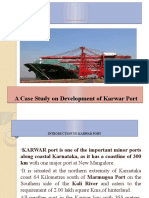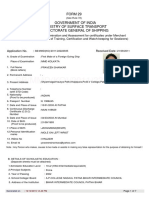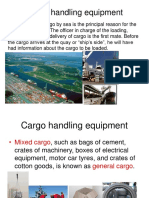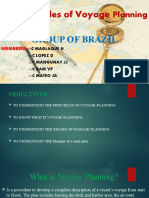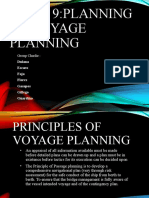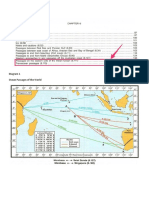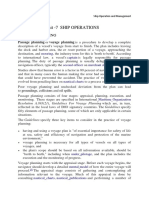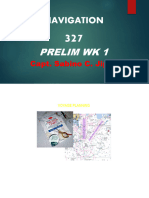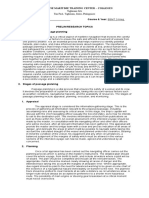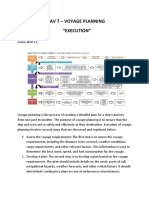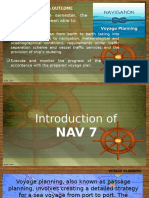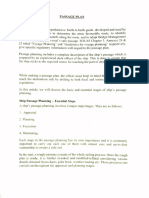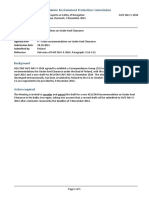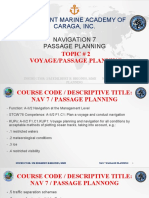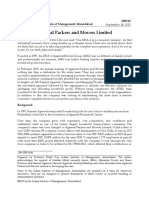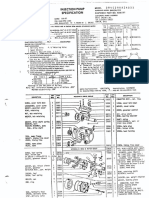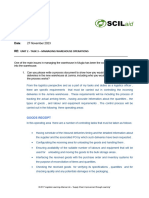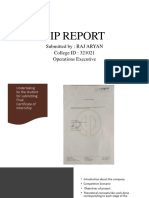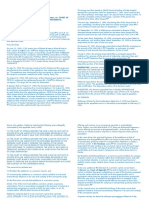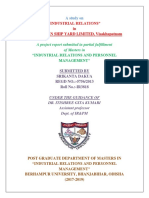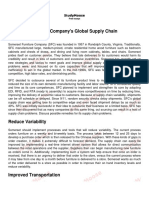0 ratings0% found this document useful (0 votes)
160 viewsLO1.8 Determine The Planning Factors of A Passage Involving Relevant Resources
LO1.8 Determine The Planning Factors of A Passage Involving Relevant Resources
Uploaded by
Jun BrionesPassage planning involves 4 key stages: 1) Appraisal of relevant information to assess risks and dangers, 2) Planning the intended voyage route on charts, 3) Executing the plan while monitoring conditions, and 4) Continuously monitoring the ship's progress against the plan and being prepared to deviate if needed for safety. The captain is responsible for passage planning according to international law, while the second officer typically handles route planning. Poor passage planning can lead to groundings, crashes and oil leaks.
Copyright:
© All Rights Reserved
Available Formats
Download as PPTX, PDF, TXT or read online from Scribd
LO1.8 Determine The Planning Factors of A Passage Involving Relevant Resources
LO1.8 Determine The Planning Factors of A Passage Involving Relevant Resources
Uploaded by
Jun Briones0 ratings0% found this document useful (0 votes)
160 views11 pagesPassage planning involves 4 key stages: 1) Appraisal of relevant information to assess risks and dangers, 2) Planning the intended voyage route on charts, 3) Executing the plan while monitoring conditions, and 4) Continuously monitoring the ship's progress against the plan and being prepared to deviate if needed for safety. The captain is responsible for passage planning according to international law, while the second officer typically handles route planning. Poor passage planning can lead to groundings, crashes and oil leaks.
Original Description:
_Nav3__LO1.8_
Original Title
_Nav3__LO1.8_
Copyright
© © All Rights Reserved
Available Formats
PPTX, PDF, TXT or read online from Scribd
Share this document
Did you find this document useful?
Is this content inappropriate?
Passage planning involves 4 key stages: 1) Appraisal of relevant information to assess risks and dangers, 2) Planning the intended voyage route on charts, 3) Executing the plan while monitoring conditions, and 4) Continuously monitoring the ship's progress against the plan and being prepared to deviate if needed for safety. The captain is responsible for passage planning according to international law, while the second officer typically handles route planning. Poor passage planning can lead to groundings, crashes and oil leaks.
Copyright:
© All Rights Reserved
Available Formats
Download as PPTX, PDF, TXT or read online from Scribd
Download as pptx, pdf, or txt
0 ratings0% found this document useful (0 votes)
160 views11 pagesLO1.8 Determine The Planning Factors of A Passage Involving Relevant Resources
LO1.8 Determine The Planning Factors of A Passage Involving Relevant Resources
Uploaded by
Jun BrionesPassage planning involves 4 key stages: 1) Appraisal of relevant information to assess risks and dangers, 2) Planning the intended voyage route on charts, 3) Executing the plan while monitoring conditions, and 4) Continuously monitoring the ship's progress against the plan and being prepared to deviate if needed for safety. The captain is responsible for passage planning according to international law, while the second officer typically handles route planning. Poor passage planning can lead to groundings, crashes and oil leaks.
Copyright:
© All Rights Reserved
Available Formats
Download as PPTX, PDF, TXT or read online from Scribd
Download as pptx, pdf, or txt
You are on page 1of 11
LO1.
8 Determine The planning factors of a
passage involving relevant resources.
• The technique of developing a full description of a vessel's voyage from
start to end is known as passage planning or voyage planning.
• The captain of a ship is legally responsible for passage planning,
according to international law.
• The navigation officer of a ship, usually the second officer aboard
commerce ships, is in charge of route planning.
• Groundings, crashes, and oil leaks can all result from poor passage
planning and unapproved deviations from the plan.
• A passage plan is intended to establish a comprehensive berth-to-berth
navigation plan in order to ensure a safe voyage by determining a path
that will be followed by: Recognizing the dangers and evaluating the risks
and decision points that come with them. Checking the depth of the water
and the amount of sea room available.
• Appraisal, planning, execution, and monitoring are the four stages of
passage planning. These stages are outlined in the International Maritime
Organization's Guidelines For Voyage Planning (Resolution A. 893(21),
which are reflected in the local laws of IMO signatory countries.
Example Of Passage Plan:
1.Appraising – all relevant
2.Planning – the intended voyage
3.Executing- the plan taking account of prevailing conditions
4.Monitoring – the vessel’s progress against the plan continuously.
Ship Passage Planning – Essential Steps
A ship’s passage planning involves 4 major steps/stages. They are as
follows:
1. Appraisal - In this stage, the master of the ship discusses with the chief
navigating officer (usually the Second Mate), as to how he intends to sail
to the destination port. (In some cases it may be required for the master
to plan the passage). This is the process of gathering all information
relevant to the proposed passage, including ascertaining risks and
assessing its critical areas. This involves information extracted from
publications as well as those within the chart.
2. Planning - Having made a full appraisal using all information at hand
pertaining to the passage, the OOW, under the authority of the Master is to
prepare a detailed plan for the passage. In this stage, the intended courses
of the ships are actually laid out on the charts of suitable scale and all
additional information is marked. The plan is laid out from pier to pier,
including the pilotage waters.
It is a good practice to mark dangerous areas such as nearby wrecks,
shallow water, reefs, small islands, emergency anchorage positions, and any
other information that might aid safe navigation.
3. Execution - In this stage, the navigating officers execute the plan that
has been prepared. After departure, the speed is adjusted based on the ETA
and the expected weather and oceanographic conditions. The speed should
be adjusted such that the ship is not either too early or late at its port of
destination. The Master should find out how long his intended voyage is,
accounting for water and fuel available. Also to be taken into account are
any expected weather changes along the way. In case and ECDIS is being
used, appropriate limits must be set with regard to the safety settings.
4. Monitoring - Monitoring is that aspect which takes into account
checking of the position of the vessel, such that it remains within the safe
distance from any danger areas. Parallel Indexing can be used to maintain
safe distance alongside any hazards to navigation. A safe and successful
voyage can only be achieved by close and continuous monitoring of the
ship’s progress along the pre-planned tracks. Situations may arise wherein
the navigating officer might feel it prudent to deviate from the plan. In such
case, he shall inform the master and take any action that he may deem
necessary for the safety of the ship and its crew. This stage is a very
important stage wherein all the deck officers contribute their part to
execute the plan. This calls for personal judgement, good seamanship and
experience.
References:
https://www.marineinsight.com/marine-navigation/understanding-the-
principles-of-passage-planning/
https://www.skuld.com/topics/ship/navigation/passage-planning-in-a-n
utshell
/
You might also like
- Cement Contract SAMPLEDocument16 pagesCement Contract SAMPLEsashka521100% (11)
- Ocean Carriers Case StudyDocument5 pagesOcean Carriers Case StudyJennifer Johnson71% (17)
- Bridge Watch Keeping, Best PracticeDocument40 pagesBridge Watch Keeping, Best PracticeRafi Muiz100% (8)
- CSI Procedure Updated V2.0Document19 pagesCSI Procedure Updated V2.0justinmae100% (1)
- MGN 166 Passage Plan GuidanceDocument4 pagesMGN 166 Passage Plan GuidancePushkar Lamba100% (1)
- Voyage Planning MGN 72Document4 pagesVoyage Planning MGN 72Amit Pandey100% (4)
- 2 1 BRM Passage PlanningDocument81 pages2 1 BRM Passage PlanningAykut Başdan100% (7)
- Piloting, Seamanship and Small Boat Handling - Vol. VFrom EverandPiloting, Seamanship and Small Boat Handling - Vol. VRating: 5 out of 5 stars5/5 (2)
- A Case Study On Development of Karwar Port A Case Study On Development of Karwar PortDocument8 pagesA Case Study On Development of Karwar Port A Case Study On Development of Karwar PortShubham GhandadeNo ratings yet
- Form 29Document7 pagesForm 29praveenNo ratings yet
- 09 - Cargo Handling EquipmentDocument25 pages09 - Cargo Handling EquipmentmarinaNo ratings yet
- Nav7 AssessmentDocument2 pagesNav7 AssessmentMj MalacaNo ratings yet
- What Is Passage PlanningDocument6 pagesWhat Is Passage PlanningKrishan Perera100% (2)
- What Is Passage PlanningDocument6 pagesWhat Is Passage PlanningKrishan Perera100% (3)
- The Principles of Voyage PlanningDocument25 pagesThe Principles of Voyage PlanningRayza Maglaque100% (5)
- Lol-1 9Document10 pagesLol-1 9cjay calaguasNo ratings yet
- GROUP-CHARLIE-Topic-9 - Planning-Of-Voyageplanning (MT33-A1) NAV 7 333L3Document18 pagesGROUP-CHARLIE-Topic-9 - Planning-Of-Voyageplanning (MT33-A1) NAV 7 333L3Christian Felix Guevarra100% (3)
- Passage Planning: Dr. Arwa HusseinDocument16 pagesPassage Planning: Dr. Arwa HusseinArwa Hussein100% (2)
- 4 Stages of Voyage PlanningDocument2 pages4 Stages of Voyage PlanningAngelo RegioNo ratings yet
- Meeting 1 Bahasa Inggris Maritim ANT 2Document9 pagesMeeting 1 Bahasa Inggris Maritim ANT 2RachmatullahNo ratings yet
- Passage Planning ArticlesDocument37 pagesPassage Planning ArticlesPrince100% (3)
- Passage PlanningDocument4 pagesPassage Planningflorenz rubrico100% (2)
- Voyage PlanningDocument11 pagesVoyage PlanningYasewn KALAWANT100% (3)
- References: 1) Nicholls's Concise Guide 2) Modern Chart Work 3) Bridge Procedures Guide 4) STCW Convention 5) The Ship Master's Business CompanionDocument118 pagesReferences: 1) Nicholls's Concise Guide 2) Modern Chart Work 3) Bridge Procedures Guide 4) STCW Convention 5) The Ship Master's Business CompanionSat Partner100% (3)
- Activity 3 Nav3Document1 pageActivity 3 Nav3CLIJOHN PABLO FORDNo ratings yet
- Far East Maritime Foundation IncDocument47 pagesFar East Maritime Foundation IncJoeven Oquendo100% (2)
- S5.2 Passage PlanningDocument13 pagesS5.2 Passage PlanningzikriNo ratings yet
- Passage Planning AlessiDocument100 pagesPassage Planning Alessiardipangulihi100% (4)
- NAV 327 Prelim WK 1Document19 pagesNAV 327 Prelim WK 1Berly FreemanNo ratings yet
- Voyage PL Anning Nav 7Document13 pagesVoyage PL Anning Nav 7Rich VistaNo ratings yet
- Costal 3Document14 pagesCostal 3Nima Conquistador100% (2)
- Passage Planning Stages, Principles, ResourcesDocument44 pagesPassage Planning Stages, Principles, ResourcesOrganis Alelxis100% (1)
- Nav 3 - Prelim Research TopicsDocument7 pagesNav 3 - Prelim Research TopicsJeremae Etiong100% (1)
- TRN 4241 Passage Planning (Outline)Document7 pagesTRN 4241 Passage Planning (Outline)Sze Ching Lam100% (2)
- Voyage PlanningDocument83 pagesVoyage Planningwsa68100% (1)
- Passage PlanningDocument44 pagesPassage Planningadithya100% (2)
- Passage AppraisalDocument12 pagesPassage AppraisalRobert M. Maluya100% (1)
- Passage PlanDocument3 pagesPassage Plankartik100% (1)
- Dizon Marco L. Nav7Document3 pagesDizon Marco L. Nav7howard santosNo ratings yet
- Bridge Procedure Guide: - Name: Çağla Taş - STUDENT ID: 20210401039 - Lecture: Seamanship 2 - Teacher:Cihat AşanDocument12 pagesBridge Procedure Guide: - Name: Çağla Taş - STUDENT ID: 20210401039 - Lecture: Seamanship 2 - Teacher:Cihat AşanÇAĞLA TAŞNo ratings yet
- NAV 327 Midterm WK 3Document31 pagesNAV 327 Midterm WK 3Berly FreemanNo ratings yet
- NAV 7.pptx Semi FinalDocument13 pagesNAV 7.pptx Semi FinalrxvistaNo ratings yet
- Describe The Principles, Purposes and Stages of The Voyage PlanningDocument2 pagesDescribe The Principles, Purposes and Stages of The Voyage PlanningChien PepitoNo ratings yet
- Passage PlanDocument4 pagesPassage Plan16 - Aniruth100% (1)
- Passage PlanningDocument18 pagesPassage PlanningEliana EscalanteNo ratings yet
- Passage Planning Explained The Workboat AssociationcDocument10 pagesPassage Planning Explained The Workboat AssociationcTablou Noduri Marinaresti100% (2)
- 03-Bridge Watch Keeping-Compiled ARHDocument24 pages03-Bridge Watch Keeping-Compiled ARHChotu SinghNo ratings yet
- Passage Planning: Dr. Arwa HusseinDocument22 pagesPassage Planning: Dr. Arwa HusseinArwa Hussein100% (1)
- Erasmus - PL - Voyage PlanningDocument23 pagesErasmus - PL - Voyage PlanningRan Oronce100% (1)
- 4-1 Draft Guidelines On Under Keel ClearanceDocument6 pages4-1 Draft Guidelines On Under Keel Clearancenakul agrawal0% (1)
- Nav 327 Prelim Week 1 4Document114 pagesNav 327 Prelim Week 1 4lochinvelosoNo ratings yet
- 1 Point: Appraisal Planning, Execution, Monitoring 4 Points AnswerDocument5 pages1 Point: Appraisal Planning, Execution, Monitoring 4 Points AnswerJncmbty vLoGsNo ratings yet
- Navigation and Watchkeeping: ScopeDocument64 pagesNavigation and Watchkeeping: ScopeAnonymous qT66pyK100% (1)
- Bridge Watch Keeping Folr 34Document57 pagesBridge Watch Keeping Folr 34Roshan MaindanNo ratings yet
- Nav.2 Module 4Document4 pagesNav.2 Module 4joeNo ratings yet
- Operational Work Based Learning Passage PlanningDocument17 pagesOperational Work Based Learning Passage Planningnav100% (1)
- Merchant Marine Academy of Caraga, Inc.: Navigation 7 Passage PlanningDocument71 pagesMerchant Marine Academy of Caraga, Inc.: Navigation 7 Passage PlanningDENWIL VINCENT MONERA100% (1)
- Bridge, Passage PlansDocument40 pagesBridge, Passage Plansrouteless.captainsNo ratings yet
- Support Level: For Oic - NW During: Planning and Scheduling The Order of Events in Anticipation of The Pilot BoardingDocument12 pagesSupport Level: For Oic - NW During: Planning and Scheduling The Order of Events in Anticipation of The Pilot Boardingdoggo tordakNo ratings yet
- 4-Master Pilot Exchange Trés ImportantDocument4 pages4-Master Pilot Exchange Trés ImportantenglisgoNo ratings yet
- Yama Adya Utha - Cadet Report 3 PDFDocument9 pagesYama Adya Utha - Cadet Report 3 PDFTaufikmalfian100% (2)
- Passage Planning - Solas RelatedDocument7 pagesPassage Planning - Solas RelatedPL BALASUBRAMANIANNo ratings yet
- NAV 327 Semi Finals AssignmentDocument5 pagesNAV 327 Semi Finals AssignmentDM ValdezNo ratings yet
- AMEM Cruise Ships On OrderDocument10 pagesAMEM Cruise Ships On OrderDudu LauraNo ratings yet
- Introduction To HeavyliftDocument30 pagesIntroduction To HeavyliftAnonymous qT66pyKNo ratings yet
- Caso de Argarwal Packers and MoversDocument21 pagesCaso de Argarwal Packers and MoversClara CuevaNo ratings yet
- Outline Agreements in SAPDocument9 pagesOutline Agreements in SAPBabarkhan MujawarNo ratings yet
- Export Insurance: Symbiosis Institute of International BusinessDocument13 pagesExport Insurance: Symbiosis Institute of International Businesssagarzawar1No ratings yet
- Impact of Globalization On TransportDocument12 pagesImpact of Globalization On Transportraavi0609100% (1)
- Accounts 11 Assignment 1 - FINALDocument10 pagesAccounts 11 Assignment 1 - FINALFerdilia GopalNo ratings yet
- Part 1: International Trade (7 Classes) Part 2: Company Internal and External Communication (Language For Business Purposes, Use ofDocument3 pagesPart 1: International Trade (7 Classes) Part 2: Company Internal and External Communication (Language For Business Purposes, Use ofAndrada Odorhean-MateuțNo ratings yet
- The Functioning Process of Logistics: A Case of Licensed Manufacturing Warehouse (LMW) in MalaysiaDocument6 pagesThe Functioning Process of Logistics: A Case of Licensed Manufacturing Warehouse (LMW) in MalaysiaSHRID460% (1)
- Chapter 9Document35 pagesChapter 9Nguyễn BìnhNo ratings yet
- Our Cranes Around The WorldDocument15 pagesOur Cranes Around The Worldbetopagoada100% (1)
- Magellan Manufacturing Marketing Corporation v. CADocument2 pagesMagellan Manufacturing Marketing Corporation v. CAquasideliks100% (4)
- DHL Express Rate Transit Guide PH enDocument25 pagesDHL Express Rate Transit Guide PH enJulie Neay AfableNo ratings yet
- Bericht BBC Baltic Port Hedland 2012Document4 pagesBericht BBC Baltic Port Hedland 2012Ralf TholenNo ratings yet
- Injection Pump Specification: .Lff.R.Document2 pagesInjection Pump Specification: .Lff.R.Miguel RojasNo ratings yet
- The Role of Distribution Center in Supply Chain ManagementDocument11 pagesThe Role of Distribution Center in Supply Chain ManagementGhaxal100% (1)
- NEXT MagazineDocument1 pageNEXT MagazineroodelooNo ratings yet
- CHL Unit 2 Task 3Document6 pagesCHL Unit 2 Task 3myahyaalaqelNo ratings yet
- Internship PresentationDocument12 pagesInternship Presentationprashantupadhyay091No ratings yet
- Land Transpotation Cases (Recovered)Document150 pagesLand Transpotation Cases (Recovered)Notaly Mae Paja BadtingNo ratings yet
- Warehouse NotesDocument22 pagesWarehouse Notesclassybanana06No ratings yet
- Project Final PDFDocument74 pagesProject Final PDFSRIKANTA DAKUA100% (1)
- DPDHL 2017 Annual Report Group Management Report PDFDocument64 pagesDPDHL 2017 Annual Report Group Management Report PDFvanNo ratings yet
- Somerset Furniture Companys Global Supply ChainDocument6 pagesSomerset Furniture Companys Global Supply ChainJohn Kelvin SalvadorNo ratings yet









